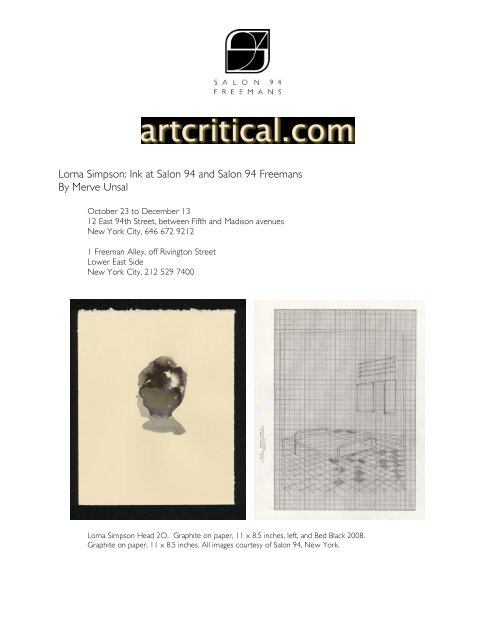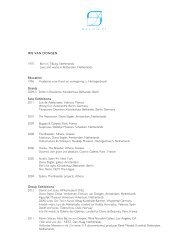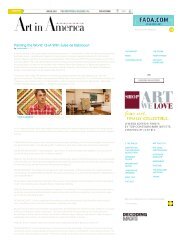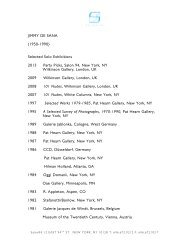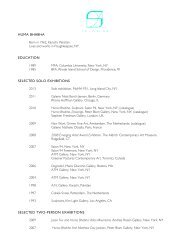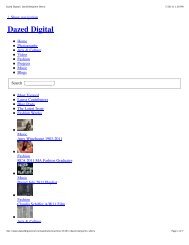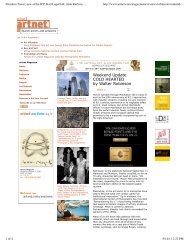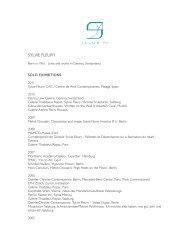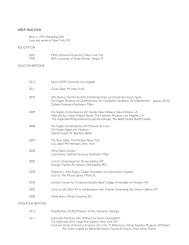Lorna Simpson: Ink at Salon 94 and Salon 94 Freemans By Merve ...
Lorna Simpson: Ink at Salon 94 and Salon 94 Freemans By Merve ...
Lorna Simpson: Ink at Salon 94 and Salon 94 Freemans By Merve ...
You also want an ePaper? Increase the reach of your titles
YUMPU automatically turns print PDFs into web optimized ePapers that Google loves.
<strong>Lorna</strong> <strong>Simpson</strong>: <strong>Ink</strong> <strong>at</strong> <strong>Salon</strong> <strong>94</strong> <strong>and</strong> <strong>Salon</strong> <strong>94</strong> <strong>Freemans</strong><br />
<strong>By</strong> <strong>Merve</strong> Unsal<br />
October 23 to December 13<br />
12 East <strong>94</strong>th Street, between Fifth <strong>and</strong> Madison avenues<br />
New York City, 646 672 9212<br />
1 Freeman Alley, off Rivington Street<br />
Lower East Side<br />
New York City, 212 529 7400<br />
<strong>Lorna</strong> <strong>Simpson</strong> Head 2O. Graphite on paper, 11 x 8.5 inches, left, <strong>and</strong> Bed Black 2008.<br />
Graphite on paper, 11 x 8.5 inches. All images courtesy of <strong>Salon</strong> <strong>94</strong>, New York.
<strong>Lorna</strong> <strong>Simpson</strong>’s two-part exhibition <strong>at</strong> <strong>Salon</strong> <strong>94</strong> <strong>and</strong> <strong>Salon</strong> <strong>94</strong> Freeman has a quiet tone. The<br />
content of her art is somber. She deals with such issues as gender, identity, war, <strong>and</strong> torture. All of<br />
these subjects are explored by <strong>Simpson</strong> with a formal sophistic<strong>at</strong>ion th<strong>at</strong> gener<strong>at</strong>es provoc<strong>at</strong>ive yet<br />
ambiguous works.<br />
In the uptown space, two bodies of work are exhibited, Photo Booth (2008) <strong>and</strong> Heads (2008).<br />
<strong>Simpson</strong>’s drawings of the backs <strong>and</strong> sides of women’s heads put a special emphasis on hairstyles.<br />
<strong>Simpson</strong> transforms hair into abstract forms. These are not simply represent<strong>at</strong>ions of specific<br />
“heads”. They are multiplicities containing poetic signifiers th<strong>at</strong> go beyond the visible world. They<br />
are reminiscent of Rorschach tests <strong>and</strong> yet they never become non-descript inkblots th<strong>at</strong> are open<br />
to any interpret<strong>at</strong>ion. The drawings are based on photographic imagery <strong>and</strong> by interpreting these<br />
found images through the drawing process, <strong>Simpson</strong> discovers new forms <strong>and</strong> ideas th<strong>at</strong> are not<br />
contained in the original m<strong>at</strong>erial<br />
The h<strong>and</strong> of the artist plays a very different role in Photo Booth (2008). These images are of black<br />
males from the 1<strong>94</strong>0s. The intim<strong>at</strong>e images are reminiscent of Carrie Mae Weems’ work, but<br />
instead of cre<strong>at</strong>ing narr<strong>at</strong>ives, <strong>Simpson</strong> juxtaposes these images to form a cloud-like shape on the<br />
wall. This shape takes on a life of its own <strong>and</strong> an element of abstraction <strong>and</strong> ambiguity is<br />
introduced within a context th<strong>at</strong> in <strong>and</strong> of itself only has historical value. The overall form cre<strong>at</strong>ed<br />
by the accumul<strong>at</strong>ion of individual photographs appears to be more important than the individual<br />
images <strong>and</strong> <strong>Simpson</strong> reiter<strong>at</strong>es this notion by interweaving inkblots among the photographs. The<br />
inkblots become weird surrog<strong>at</strong>es for the photographs, filling gaps to complete a “big” picture. The<br />
artist becomes a medi<strong>at</strong>or of found images <strong>and</strong> the marks she makes. The viewer is responsible for<br />
interpreting this tapestry consisting of personal images of men who are self-consciously posing for<br />
snapshots.<br />
<strong>Lorna</strong> <strong>Simpson</strong> Long, Slow, War (Still) 2008. 2-channel video projection, dimensions variable
The tensions between intim<strong>at</strong>e <strong>and</strong> public, between inform<strong>at</strong>ion <strong>and</strong> interpret<strong>at</strong>ion, found in the<br />
uptown space, take on a different meaning in wh<strong>at</strong> <strong>Simpson</strong> calls the “orchestr<strong>at</strong>ed the<strong>at</strong>rical<br />
disaster” of war. At the Freeman Alley venue, a piece called Long, Slow, War (2008) are<br />
juxtaposed with a set of drawings of interior spaces from the same year; these l<strong>at</strong>ter took their<br />
titles from the motif depicted in each drawing. The graphite drawings, on sheets of graphing paper,<br />
reminiscent of interior design sketches, are based on published images of war (either dissemin<strong>at</strong>ed<br />
by the government or the soldiers themselves). The drawings emphasize the ubiquitous quality of<br />
war imagery in our culture, but when viewed all together, there is something uncanny about their<br />
barrenness. The mental spaces cre<strong>at</strong>ed by these drawings could be defined as a heterotopia; the<br />
viewer is not completely detached from the reality of the images from which these drawings are<br />
reproduced <strong>and</strong> yet the drawings do not make the reality of the events taking place pertinent.<br />
The disorient<strong>at</strong>ion caused by the drawings urges the viewer to take them in in conjunction with the<br />
two video projections presented in the same gallery. The video projections are footage from<br />
Thomas Edison’s Railroad Smash-up (1904) <strong>and</strong> Fourth of July fireworks along with the aural<br />
element of slowed down sounds of train crashes <strong>and</strong> fireworks. <strong>Simpson</strong>’s criticism of the<br />
“spectacle of war” is more direct in the video works, whereas the drawings give the viewer more<br />
room for priv<strong>at</strong>e deliber<strong>at</strong>ion <strong>and</strong> free-associ<strong>at</strong>ion.<br />
The subversive beauty th<strong>at</strong> has been present in <strong>Lorna</strong> <strong>Simpson</strong>’s work since W<strong>at</strong>erbearer (1986)<br />
has reached a new level of refinement in the priv<strong>at</strong>e world of her new drawings <strong>and</strong> “collected”<br />
imagery. These new drawings address critical issues th<strong>at</strong> are important to the artist while giving the<br />
viewer just enough mental space to experience precious moments of deliber<strong>at</strong>ion. It is the melding<br />
of formal sophistic<strong>at</strong>ion with the artist’s honest yet poignant perspective on critical issues th<strong>at</strong><br />
makes <strong>Simpson</strong>’s work transcend boundaries <strong>and</strong> definitions <strong>and</strong> any <strong>and</strong> all expect<strong>at</strong>ions.


